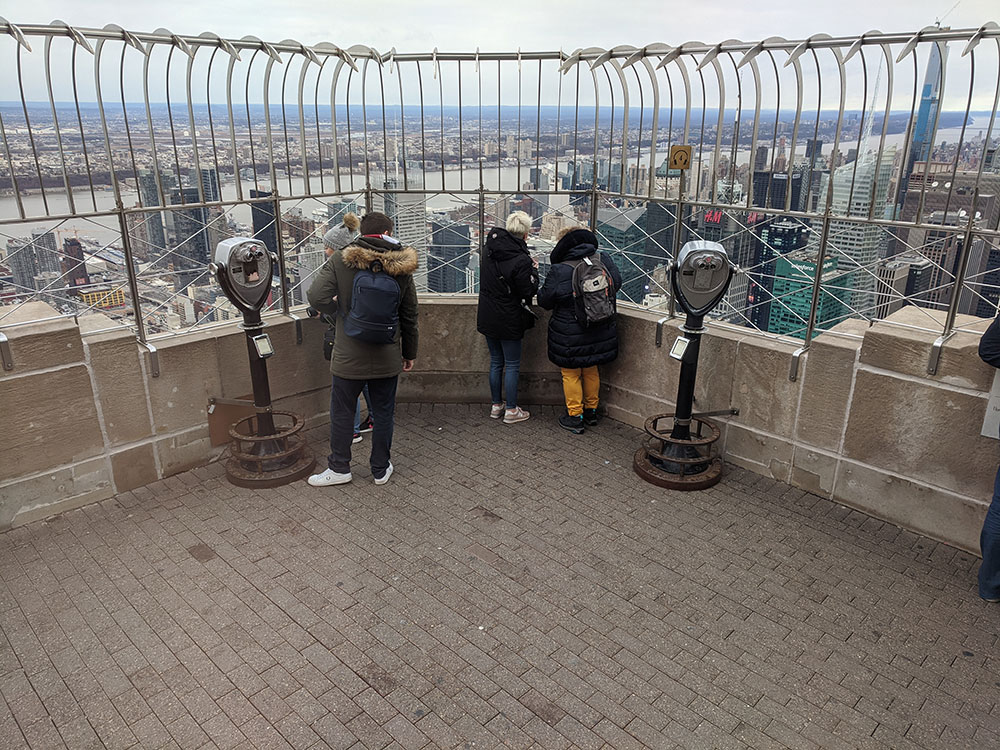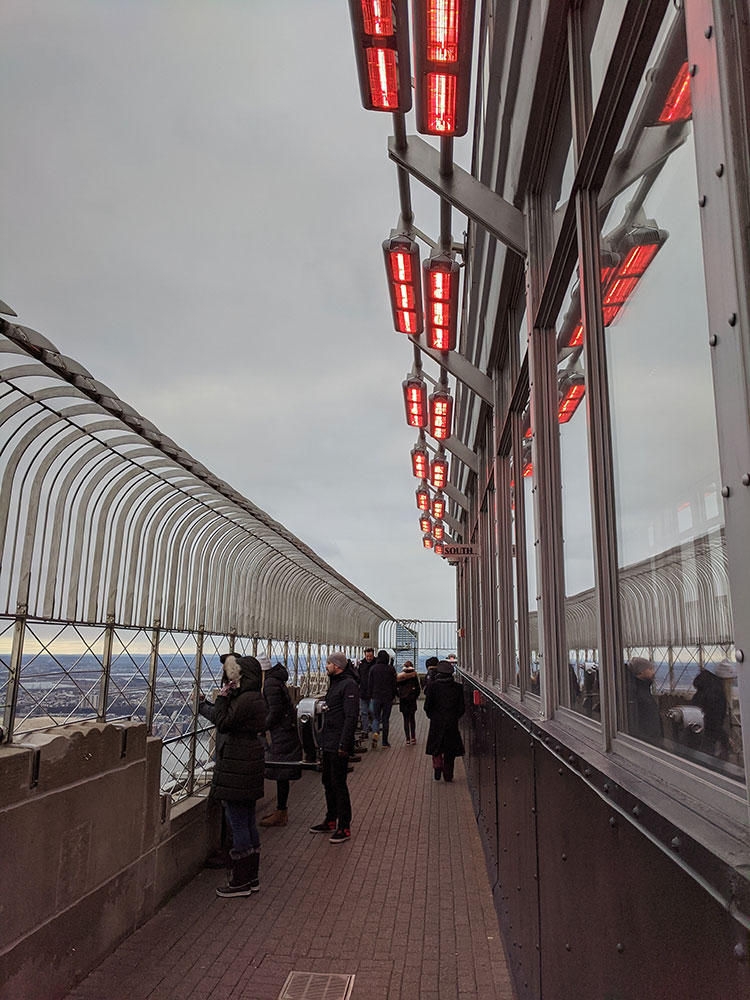Iconic 102-story Art Deco skyscraper in Midtown Manhattan
General Information
Friday to Sunday: 11am to 10pm
86th Floor Observatory
Prices starting at:
Adult: $42.00
Child: $36.00
Senior: $40.00
102nd and 86th Floor Observatories
Adult: $75.00
Child: $69.00
Senior: $73.00
Night Pass
Lets you return to 86th floor observatory after dark and see nighttime Manhattan lights
Prices starting at:
Adult: $52.00
Child: $45.00
The Empire State Building is a 102-story Art Deco skyscraper in Midtown Manhattan. Its name is derived from "Empire State", the nickname of the state of New York. The building has a roof height of 1,250 feet (380 m) and stands a total of 1,454 feet (443.2 m) tall, including its antenna. The Empire State Building stood as the world's tallest building until the construction of the World Trade Center in 1970.
The site of the Empire State Building, in Midtown South on the west side of Fifth Avenue between West 33rd and 34th Streets, was developed in 1893 as the Waldorf-Astoria Hotel. In 1929, Empire State Inc. acquired the site and devised plans for a skyscraper there. The design for the Empire State Building was changed fifteen times until it was ensured to be the world's tallest building. Construction started on March 17, 1930, and the building opened thirteen and a half months afterward on May 1, 1931.
-750.jpg) Sam Valadi, Public domain, via Wikimedia Commons; Image Size Adjusted
Sam Valadi, Public domain, via Wikimedia Commons; Image Size AdjustedThe building's Art Deco architecture, height, and observation decks have made it a popular attraction. Around four million tourists from around the world annually visit the building's 86th- and 102nd-floor observatories; an additional indoor observatory on the 80th floor opened in 2019. The Empire State Building is an American cultural icon: it has been featured in more than 250 TV shows and movies since the film King Kong was released in 1933. The building's size has become the global standard of reference to describe the height and length of other structures. A symbol of New York City, the building has been named as one of the Seven Wonders of the Modern World by the American Society of Civil Engineers. It was ranked first on the American Institute of Architects' List of America's Favorite Architecture in 2007. Additionally, the Empire State Building and its ground-floor interior were designated city landmarks by the New York City Landmarks Preservation Commission in 1980, and were added to the National Register of Historic Places as a National Historic Landmark in 1986.
The Empire State Building is located on the west side of Fifth Avenue in Manhattan, between 33rd Street to the south and 34th Street to the north. Tenants enter the building through the Art Deco lobby located at 350 Fifth Avenue. Visitors to the observatories use an entrance at 20 West 34th Street; prior to August 2018, visitors entered through the Fifth Avenue lobby.
 Carol M. Highsmith, Public domain, via Wikimedia Commons; Image Size Adjusted
Carol M. Highsmith, Public domain, via Wikimedia Commons; Image Size AdjustedThe areas surrounding the Empire State Building are home to other major points of interest, including Macy's at Herald Square on Sixth Avenue and 34th Street, Koreatown on 32nd Street between Madison and Sixth Avenues, Penn Station and Madison Square Garden on Seventh Avenue between 32nd and 34th Streets, and the Flower District on 28th Street between Sixth and Seventh Avenues. The nearest New York City Subway stations are 34th Street-Penn Station at Seventh Avenue, two blocks west; 34th Street-Herald Square, one block west; and 33rd Street at Park Avenue, two blocks east. There is also a PATH station at 33rd Street and Sixth Avenue.
The Empire State Building's art deco design is typical of pre-World War II architecture in New York. The facade is clad in Indiana limestone panels sourced from the Empire Mill in Sanders, Indiana, which give the building its signature blonde color. According to official fact sheets, the facade uses 200,000 cubic feet (5,700 m3) of limestone and granite, ten million bricks, and 730 short tons (650 long tons) of aluminum and stainless steel. The building also contains 6,514 windows.
 Jllm06, CC BY-SA 4.0, via Wikimedia Commons; Image Size Adjusted
Jllm06, CC BY-SA 4.0, via Wikimedia Commons; Image Size AdjustedThe 80th, 86th, and 102nd floors contain observatories. Since opening, the observatories have been more popular than similar observatories at 30 Rockefeller Plaza, the Chrysler Building, the One World Trade Center, or the Woolworth Building. There are variable charges to enter the observatories; one ticket allows visitors to go as high as the 86th floor, and there is an additional charge to visit the 102nd floor. Other ticket options for visitors include scheduled access to view the sunrise from the observatory, a "premium" guided tour with VIP access, and the "AM/PM" package which allows for two visits in the same day.
The 86th floor observatory contains both an enclosed viewing gallery and an open-air outdoor viewing area, allowing for it to remain open 365 days a year regardless of the weather. The 102nd floor observatory is completely enclosed and much smaller in size. The 102nd floor was redesigned in a project that was completed in 2019, allowing the windows to be extended from floor to ceiling and widening the space in the observatory overall. An observatory on the 80th floor, opened in 2019, includes various exhibits as well as a mural of the skyline drawn by British artist Stephen Wiltshire.
This article uses material from the Wikipedia article "Empire State Building", which is released under the Creative Commons Attribution-Share-Alike License 3.0
 DanielPenfield, CC BY-SA 4.0, via Wikimedia Commons; Image Size Adjusted
DanielPenfield, CC BY-SA 4.0, via Wikimedia Commons; Image Size Adjusted DanielPenfield, CC BY-SA 4.0, via Wikimedia Commons; Image Size Adjusted
DanielPenfield, CC BY-SA 4.0, via Wikimedia Commons; Image Size Adjusted